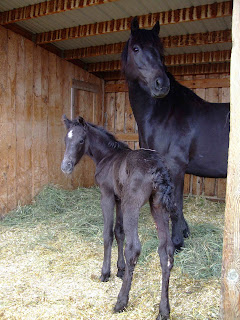Number 3. Sell and Rehome Responsibly. Heidi's Top 10 Equine Stewardship Practises.
Heidi's Top 10 Stewardship Practises. I don't want to tell anyone what to do, or give out free "advice". But, I do want to encourage responsible horsemen to think more deeply. Many people do not think things through, and actually say or influence others with statements that are not accurate. If horsemen took the time to think things through, they may act differently in some situations. Perhaps, these practises which I strive to abide by, may help others develop their own top 10 stewardship practises. So, what does the responsible horsemen do to demonstrate stewardship?
Number 3. Sell and Rehome Responsibly. Take the time to make sure the horses you are responsible for go to responsible homes.
When breeders raise and develop a horse for a specific purpose of sale, an entire economy is supported - veterinarians, feed producers, supplement developers, farriers, trainers, equipment manufacturers, artists, saddle builders and that economy is supported by many more volunteers from the dad who builds the riding ring at home after work, to the countless supporters of 4H, pony club, horse shows, volunteer run equine sporting organizations; the list goes on. A question I now write, is this. If you are a breeder putting all that into a horse, how could you let your horse go to any home that is not the best possible home for that horse? Wouldn't it be better to hold onto your "product" until someone is going to take it to another level, and show off what you helped to create? And if you were an owner, or steward of a horse, having made the commitment of caring for that animals best interest, would you not want to see that horse go to someone who is as well, if not better suited to that horse than yourself if you needed to sell? Still, good, no, exceptional horses end up in places and situations you can only shake your head at. A sad state of affairs. Why are horses ending up with the wrong partner, doing the wrong thing or worse off, not having a job at all and worse ever, ending up needing to be rescued?
 |
| We all feel great when our horses are in good hands, doing a job and being cared for properly. |
The Ontario Standardbred Adoption Society (OSAS), does an outstanding job of ensuring horses in their care (these are standardbred race horses who are no longer racing) go to appropriate homes. In the adoption application form OSAS writes, "adopted horses may never be bred, raced, sold, leased, given away or commercially used." (Commercially used refers to slaughter). Their goal is to find these horses good, loving, lifetime homes. OSAS takes their horses back if the new owner can not keep them anymore and “rehomes” them almost immediately. The organization even has guardians; volunteer horsemen who help out the new owners and provide support when needed. Horses in the program come from Standardbred breeders or race horse owners who receive a tax receipt for the donation of the horse. They are then rehabilitated, retrained, and kept in paid foster homes until placed. While a costly process, the program is funded by the racing industry itself, as well as fund raising programs and private donations! Wow, what a way to stand behind your horse breed. Other breed organizations have also stepped up to the plate, the good news stories of this kind are too numerous to write about. Cavalia, the amazing Canadian production that celebrates the horse, featured two horses that Alberta based, Bear Mountain Horse Rescue had saved. There is a question, what are two horses, suitable for performing with the Cavalia troup, doing in a situation where they need rescue?
You do not have to be a not for profit organization to insist that the horse you bred, raised, trained, and marketed for sale, goes to an appropriate home. Many individual breeders and trainers work to ensure the horses they raised are sold to suitable homes. I know more than one horse breeder who stands behind the horses they raise and train, and understands if the partnership does not work out on the rare occasion with a new owner. It can be a financial set back but breeders who are willing to put in the time to take the horse back, get it back on track and make sure that horse finds the right human partner help make sure everyone, especially the horse and rider succeed. Better that than risk the horse being passed on to another improperly matched owner, which begins the downward spiral where the horse is inevitably blamed for humans poor choices. The Unwanted Horse Coalition 2009 Unwanted Horse Survey reports that many horsemen feel that continuing to educate owners to purchase and own responsibly, is an important practise.











